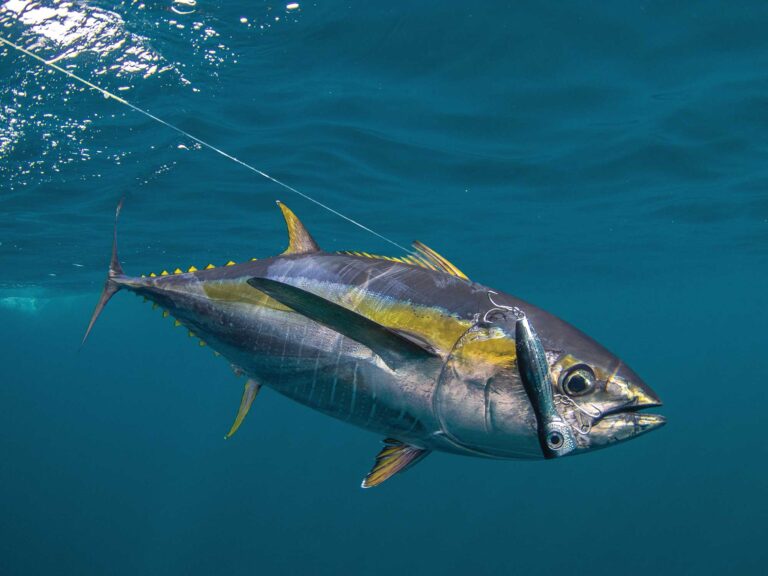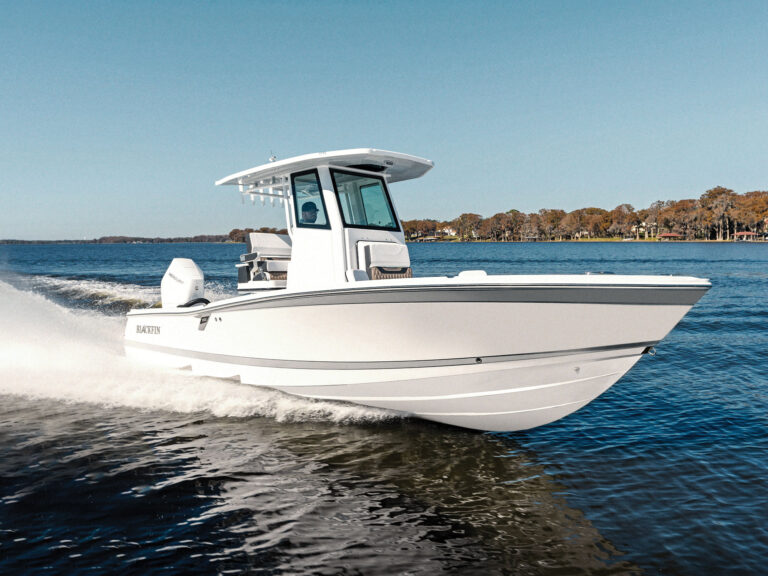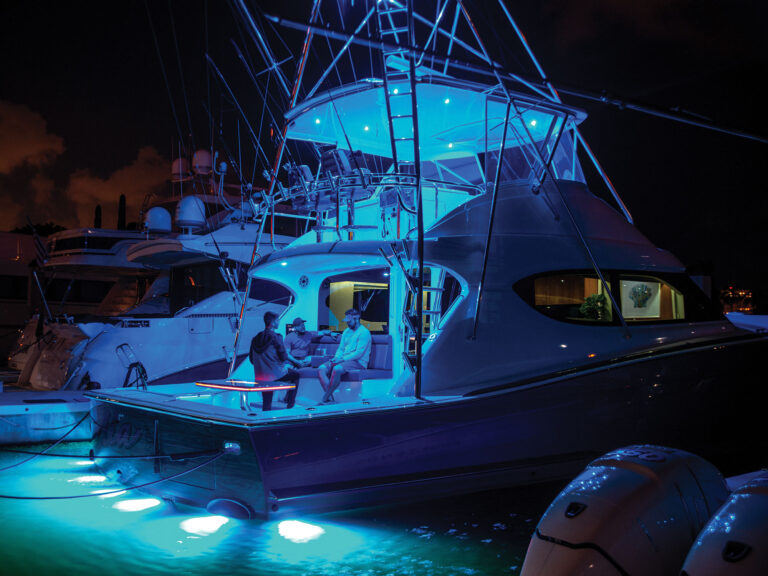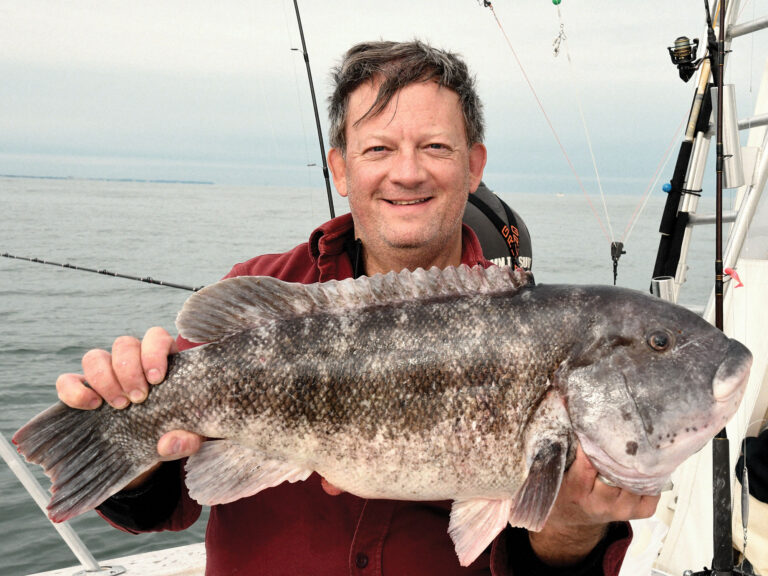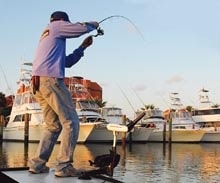
|| |—| || |DOCK MASTER: Don’t overlook marinas when hunting big fish. Photo: Scott Sommerlatte| I caught one of my biggest tarpon ever at a Fort Lauderdale boat ramp one evening, after I had loaded my boat onto the trailer. I was tossing out the remaining pilchards from my live well, only to have the dark silence broken by the distinctive sound of a tarpon blasting them.
I rigged a 20-pound spinning outfit with an 80-pound leader and a 7/0 circle hook. Baiting up with a live pilchard, I hooked the tarpon in seconds. I expected it to break off on a piling. But thanks to some fancy footwork down the seawall, I whipped the estimated 180-pounder in 45 minutes, removed the hook and set it free.
That tarpon reminded me that we often outthink ourselves and motor past nearby hot spots, because we don’t consider them to have prime fishing. Here are five offbeat targets that can yield quality fish.
Ramp It Up
That night at the ramp, I could hear the feeding tarpon. Think about it: All those bait coolers that get dumped at the ramp must draw in plenty of gamefish for the evening feed. Bait discards lay on the bottom and attract small fish and crabs, which bring in tarpon, red drum or stripers.
Your best chances of popping a quality fish are in the evening or well before sunrise. If you’re early and waiting for a friend, launch your boat, tie it up and try casting a plug or soaking a bait. Scoring a great catch on your own before leaving the ramp is not a bad way to start the day.
Traffic’s the Ticket
Passages to marinas are great spots to nail a trophy fish, for three reasons. First, the confined area narrows the “window” of water you need to search. Second, predators use breakwaters, rocks or pilings to ambush bait washing in and out of the marina with the tides. Finally, many anglers clean fish or dump bait off their boats and turn on their transom lights in the evening, drawing in baitfish.
Late one evening, my fishing partner bet I couldn’t catch a snook near a canal that connected the Intracoastal Waterway to a major marina. Just two casts later, we were into a 30-pounder. He was shocked when that fish came to boatside.
Try a bucktail, a live bait or even a topwater plug to score with a striped bass, snook, tarpon, fluke or snapper lurking around a marina entrance. No matter what, keep a man at the helm in these tight, high-traffic areas.
Channeling Spirits
Channel markers along the Intracoastal Waterway, which many anglers race past en route to the inlet or pass, can hold a variety of fish too.
Depending on where you fish, these markers can produce Spanish mackerel, sheepshead, tripletail, grouper, fluke, ‘cuda, seatrout, redfish, stripers, blackfish, snook and others.
What do I look for in a marker? Structure and water flow are two keys. Pull up to the marker with the boat and look at the conditions.
Circle it slowly while studying your fishfinder-those with rubble and rocks at their bases tend to hold bait and attract game. Water flow facilitates the transfer of bait, and stimulates the feeding of gamefish.
Rock the Dock
I took one of my largest seatrout-a seven-pounder-by pitching a live mojarra underneath a boat lift along a shallow stretch of shoreline. The water wasn’t much deeper than three feet, but a rut beneath the boat provided an extra foot of depth. The twin-engine 25-footer on the lift created that rut with its props, leaving depressions devoid of grass. The dark mud retains heat, which concentrates fish on cold days.
We suspected a trout or redfish would be comfortable in that hole. Sure enough, I felt the jolt of a strike and had a tough tussle on 12-pound spinning tackle to keep the fish from breaking off on a piling. My reward was a big, beautiful trout.
Paid Under the Table
It may be hard to imagine idling up to a fish-cleaning table to wet a line, especially when people holding knives look at you like you’re nuts or just a little desperate. But, if it’s allowed and you don’t interfere with anyone, the waters under the fish-cleaning table are where the skunk leaves the boat. You may score a big fish-and freak out your shore-based audience. Try late afternoon, when cleaning tables see the most use. But be prepared to hear plenty of abuse.
Fight in Tight
Toughen up your tackle around structure.
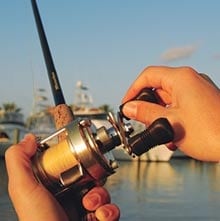
| |BEND AND STRETCH?: Braided line can help you put the hurt on a trophy fish hooked close to structure. Photo: Scott Sommerlatte| When seeking big fish in tight quarters, step up your gear. It will let you maximize the pressure on a fish immediately and get it out of that hostile environment.
Defensive Line: Whether you’re tied to a 50-pound tarpon or 15-pound striped bass, do like an old football coach would say: “Stop the run.” Your starting point for mono is 25-pound test-no lower. Plan for larger, tougher fish with 80-pound line.
Up-Braided: Superbraid lines have no stretch and stand up to abrasion well, letting you turn a fish away from the structure and toward the boat. The small diameter of braid cuts through the water and lets you take the belly out of the line more quickly.
Thick Stick: Heavy line won’t make a difference if the rod can’t apply enough power to help you turn a stubborn and powerful fish. Start with a strong rod and finish the fight that much quicker.
Hook Up: Upgrade to larger hooks or stronger versions of the size you usually use. There’s nothing worse than a straightened, bent or broken hook-it means you lost a fish that was really worth catching.
Get Cranky: When spooling up with heavier line, make sure the the gears in your reel can withstand the extra pressure. And that goes for the drag as well. Use your top-of-the-line reels when you get down and dirty.
– G.P.





